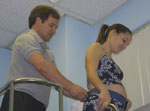Wellness Center device measures body fat percentage
by Heather WoolwinePublic Relations
When Erin Blake became pregnant for the second time, she wanted to keep track of her weight gain in a more efficient manner than simply jumping on the scale or having someone pinch her skin.
That’s where Dwight Gore, MUSC Wellness Center, and his large tank of water came in.
 Erin
Blake gets ready to take her second body composition measurement while
Dwight Gore, MUSC Wellness Center, checks the breathing tube connection
to his computer.
Erin
Blake gets ready to take her second body composition measurement while
Dwight Gore, MUSC Wellness Center, checks the breathing tube connection
to his computer.
In 1991, Gore first began working with former MUSC physician Les Organ, M.D., on body composition research using an underwater weighing tank. Specifically, they were looking for a more accurate equation for bioelectrical impedance with adult and adolescent participants.
What sparked Gore’s interest in looking at the body composition of pregnant women was a visit from a Wellness Center aerobics instructor who wanted to keep track of her body fat percentage during her pregnancy.
But why use water and not the good old pinch tests or scales?
 Dwight
Gore, MUSC Wellness Center, adjusts the weight belt to fit Erin Blake's
pregnant frame.
Dwight
Gore, MUSC Wellness Center, adjusts the weight belt to fit Erin Blake's
pregnant frame.
In air, muscle and fat weigh the same but things change when the human body is immersed in water. Essentially, the body can be broken down into five categories: the water in the body (which is neutral with the water in the tank), muscle and bone (which sink), body fat (which floats), and the air in the lungs (which floats).
“The computer looks at the ratio of the parts of the body that sink and the parts that float and uses this to determine a percent body fat,” Gore said. “We perform two weigh-ins for a given individual; those readings should be within 1 to 1.5 percent of each other. That’s how you know that you’re getting an accurate reading. Sometimes a third trial is necessary. The great thing for pregnant women is that they can take what they learn about their body composition and explain to their physician what’s going on with their weight-gain. It makes it easier for everyone to understand the weight (fat and muscle) changes associated with pregnancy.”
Pregnant women are not the only ones who use the tank. Indeed, others concerned with their body composition, like professional athletes or military personnel, have also used it.
The tank does involve going completely underwater with the help of a breathing tube that also serves to register the amount of air in the lungs.
“At first, I was apprehensive about going underwater,” Blake said. “But I really wanted to understand the changes my body was going through during this pregnancy. It is kind of intimidating but it’s worth it because it really lets you know where you are. When you’re pregnant it’s hard to determine what part of the weight gain is you or the baby.”
“Mom told all of us when we were growing up that you can’t breathe under water,” Gore said. “So your first thought when you get in the tank, is ‘I can’t breathe,’ even with the tube in your mouth. For those out there that scuba and snorkel, they’re already over it, but the rest of us have to learn it.”
Blake not only benefits from knowing her true body composition, but because she is so petite, she and many others like her are able to show their physicians that they do, in fact, weigh enough to even become pregnant in the first place.
Without the more accurate body composition information, some women could be told by their physicians to gain some weight before attempting to become pregnant.
In order to get an accurate reading, Gore must coach participants on how to breathe underwater and proper positioning in the tank’s chair. He can adjust the amount on the weight belt for each individual.
“The time in the tank is reduced with each visit,” Gore said. “Usually by the third appointment they remember the process and want to skip right to the weighing.”
Gore explained that the average person concerned about their body composition probably doesn’t need the tank but instead needs a person from whom they can receive an accurate skin fold pinch test.
Using the tank is free to pregnant women, $40 for others, and by appointment only.
“It may not be the easiest way to get a body composition measurement, but it is certainly the most accurate,” Gore said. “We’ve been written up as one of the most accurate tanks in the world.”
For information about the tank or to set up an appointment, e-mail goredt@musc.edu
or call 792-5754.
Friday, Feb. 11, 2005
Catalyst Online is published weekly, updated
as needed and improved from time to time by the MUSC Office of Public Relations
for the faculty, employees and students of the Medical University of South
Carolina. Catalyst Online editor, Kim Draughn, can be reached at 792-4107
or by email, catalyst@musc.edu. Editorial copy can be submitted to Catalyst
Online and to The Catalyst in print by fax, 792-6723, or by email to petersnd@musc.edu
or catalyst@musc.edu. To place an ad in The Catalyst hardcopy, call Community
Press at 849-1778.